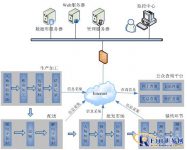
Meat and vegetable food circulation traceability management system
[ad_1]
introduction
The food circulation traceability system is based on RFID technology, based on the development of modern circulation methods, and uses information collection technology, information transmission technology and information processing technology to realize the circulation of meat, vegetables and other foods and commodities, as well as purchase and sales accounts. Electronic, thus forming a quality and safety traceability chain with traceable sources, verifiable whereabouts, and accountability.
This system uses RFID technology and related information transmission technology and information processing technology to establish a regionalized whole-process food circulation safety traceability system, and integrates livestock breeding, slaughter and processing, vegetable planting, food processing, transportation, wholesale, retail and other links into the supply chain Online supervision system, so as to realize the traceability of the whole process of food circulation, can detect and deal with counterfeit and inferior food in the first time, so that problems can be detected and dealt with early, which effectively reduces the probability of occurrence of problems, improves consumer confidence, and guarantees The health and life safety of the people.
System Block Diagram

System functions
1. Information collection and traceability
From production to sales of food, there are mainly the following links: raw material procurement, processing, distribution, wholesale, and retail. This solution starts from the raw material link and uses real-time information from different forms of RFID electronic tags and RFID identity cards of supply chain business personnel Binding, uploading and downloading quality information and data with processing links, distribution links, wholesale and retail links, realizing forward tracking of relevant information from raw materials to food retail terminals, and also realizing reverse traceability from food retail terminals to raw material-related information , So as to effectively restrain the operators in the food supply chain, and strongly support the supervision and comprehensive analysis of the food circulation by the government authorities.
2. Information supervision
In view of the characteristics of food safety supervision, this system can be divided into two parts: the front-end data collection end and the back-end data management end: the front-end data collection refers toRFIDThe core technology is the basis for real-time monitoring of food-related production site activities, and the collection of process data information; back-end data management refers to the use of the real information reported in each link of the front-end collection for statistics, analysis, distribution, etc., and the supervision and support platform architecture Adopt a centralized construction method, build a unified supervision platform at the provincial level, and reserve an interface with the national food processing industry management information system, and the three-level entities of the province, city, and county use it in accordance with the corresponding authority. The supervision platform is divided into a front-end main interface and a back-end operation interface, responsible for data collection, analysis, query and monitoring of all links in the entire food supply chain.
3. Consumer inquiries
After purchasing food, consumers can query the information of the purchased food through various means such as SMS, Internet, telephone, self-service terminal, etc., according to the traceable receipt obtained, including the origin of raw materials, suppliers, production and processing enterprises, wholesalers, and retailers , Shelf life, etc., to ensure that the food source is guaranteed and the quality is guaranteed.
System Features
1. Using a variety of information technologies, a complete supervision system of planting and breeding, food processing, supply chain, and consumers has been formed, which has improved the supervision capabilities of government departments and ensured food safety;
2. Compress the living space of counterfeit and inferior food, reduce the business risk of the enterprise, and improve the economic benefit of the enterprise;
3. Strengthen the management and control of the process, and form an effective production and operation restriction mechanism;
The accuracy of inspection and quarantine has been improved, the confidence of consumers has been improved, and the health and life safety of the people have been protected.
[ad_2]



